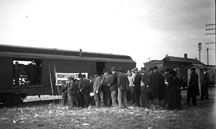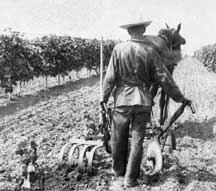Centennial of the State Fruit Experiment Station
(revised June 7, 2005)
by Marilyn Odneal
The State Fruit Experiment Station marked 100 years of public service on November 15, 1999. The Station was established by an act of the Missouri legislature to serve the fruit production and processing industries of Missouri. The Station operated as a state agency under a board of trustees appointed by the governor before the station became part of Missouri State University in 1974. Dr. Innocent Onwueme serves as the seventh director of the State Fruit Experiment Station having been preceded by James F. Moore Jr. (1984 - 2004), Kenneth Hanson (1963 - 1984), Paul Shepard (1934 - 1961), Frederick W. Faurot (1918 - 1933), Paul Evans (1903 - 1918), and John T. Stinson (1899 - 1902).
The first director of the State Fruit Experiment Station, J. T. Stinson, introduced the saying "an apple a day keeps the doctor away". The health benefits of eating fruit have since been incorporated in the FDA recommendations for a healthy diet. Former director Paul Shepard, in a 1951 article on his research projects in the St. Louis Post-Dispatch, foretold that "There's a good day coming when vineyards will garland the Ozark hills and wine flowing from the presses will bring wealth to the growers." The state has since experienced a rebirth of the grape and wine industry, with fifty-two Missouri wineries in business today. The State Fruit Experiment Station continues to promote the Missouri Fruit Industry with continuing research, advisory, education, and public service programs.
Several commercially important fruit cultivars were released from the State Fruit Experiment Station including Ozark Gold apple, Loring and Topaz peach, and Ozark Premier and Bluefre plum. The traditional breeding program at the Experiment Station was discontinued in 1985. Fyan, although not a commercially important apple, is named after the original town of Mountain Grove.

At the turn of the century, outreach education was carried out by using railroad cars to move displays and scientists from town to town. (Photo from the archives of the State Fruit Experiment Station).At the turn of the century, outreach education was carried out by using railroad cars to move displays and scientists from town to town. (Photo from the archives of the State Fruit Experiment Station).

Clean cultivation was practiced at the State Fruit Experiment Station at the turn of the century. A grass cover between rows is now recommended to prevent soil erosion.